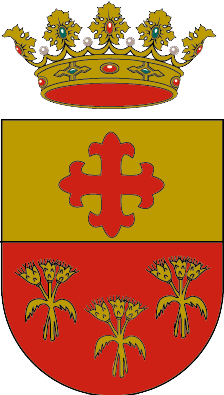History

Having studied the historical context of the locality and municipality of Famorca, province of Alicante, as well as the characteristics and peculiarities of said locality, as stated and collected in the above-mentioned book of which he is the author, and the statements made by other authors and documents which are cited, I believe, in my opinion, that the most appropriate Heraldic Shield Project for said Municipality should be composed of the following elements:
Description: Split and half cut shield.
First barracks: In silver field a strip of azure accompanied on the top, of an olive tree of sinople, terraced of the same; and in the lowlands, a natural mountain with the opening of a chasm.
Second quarter: In field of gold, florized cross of gules.
Third quarter: In field of gules, three golden thistles put in triangle.
To the timibre: Royal Crown.
First barracks: Professor María Desamparados Cabánes Pecourt in “Documents and data for a toponymic study of the Valencia Region” (1981. pp. 427) indicates with respect to Famorca: “It has no documentation. Sanchís Sivera says that at the time of the Blessed Patriarch it consisted of twelve houses of new Christians (Sanchís, Nomenclátor, page 228). Coramina includes the place name in the list of Mozarabic geographical voices. (Cf. Corom, Estudis 1, page 254), although it does not venture any interpretative hypothesis. Perhaps the initial F is secondary, not etymological, and you have to think of the Latin AMURCA «oil slick».
In my work “The valleys of Seta and Travadell” (1976, page 27, note 47) the undersigned indicated: “Given the Majorcan repopulation in this region, it would be to see if Famorca derives from corruption of the article Sa-morca (medieval writing) Sa-morca with reference to oil, cultivation of the region). In this regard, in terms of Plans, there is a farmhouse known in the region for “More of the Morquera”, with the same reference to oil
In the «Diccionari Catalá-Valenciá-Balear», by Mosén Antonio María Alcover, we find the voice «MORCA = alpechín, amurca, morga; with the etymology of the Latin amurca ». The mountain refers to the Sierra Serrella, which frames the municipal area together with the Alfaro mountain range, in whose Serrella mountain range there is a 30 meter deep chasm, known as “Avene de Famorca”.
It is all that can be stated in relation to the request. The Municipal Corporation, however, will agree what it deems most convenient. ”

